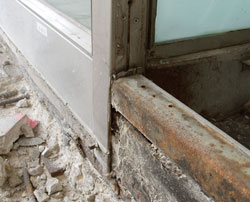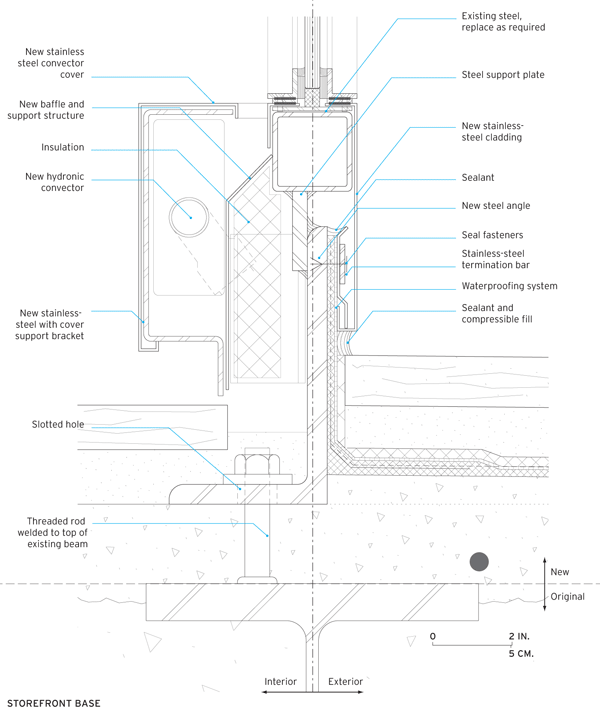Reviving
Retrofitting the mechanical systems to alter the buildings' pressurization was not in the project's scope, so the consultants tackled the water-infiltration problem by replacing the bottom foot of the storefront, where the deterioration was most severe. Above the base, they opted to keep the existing system mostly intact. The team preserved much of its steel-tube structure, which was believed to be original fabric. And because of budget concerns, they also retained the storefront's stainless-steel cladding, even though it had been installed by Holabird & Root as part of a 1980s renovation in place of Mies's aluminum cladding. "We could not replace the whole system," explains Gunny Harboe, FAIA, the project's preservation consultant. "We had to work with what was there."Â
 |
The plaza's poor drainage caused deterioration of the lobby storefront, especially at the base. Photos courtesy Krueck & Sexton |
Although the storefront reconstruction efforts were concentrated at its base, the work should greatly improve the enclosure's long-term performance. The retrofit made proper termination of the plaza's new waterproofing system possible. It also allowed designers to raise the exterior pavers 1 1â„2 inches relative to the lobby floor and create the desired water-shedding slope.
As part of the storefront work, the project team also replaced the glazing at the lobby's back-of-house spaces. In the original, Mies had installed glass sandblasted on the inside face, much as he would later do at Crown Hall, to hide the activity within from view. However, the porous and textured surface proved vulnerable to staining and scratching and was replaced during the Holabird & Root renovation with laminated glass containing a PVB (polyvinyl butyral) interlayer. The substitution eliminated the staining and scratching problems and satisfied new codes requiring safety glass in such installations. It also simulated the effect of the sandblasted glass, but subtly changed the character of the storefront. "Laminated glass is more translucent and less transparent than sandblasted glass," explains Sexton.
Luckily, glass technology has advanced considerably in recent decades, allowing Sexton and the team to find a solution that would respond to code and maintenance requirements and be historically accurate. They specified clear glass that was both sandblasted and tempered (a combination not yet available at the time of the earlier renovation). And to prevent marking of the glass, they included a clear epoxy coating on the textured face.
 |









